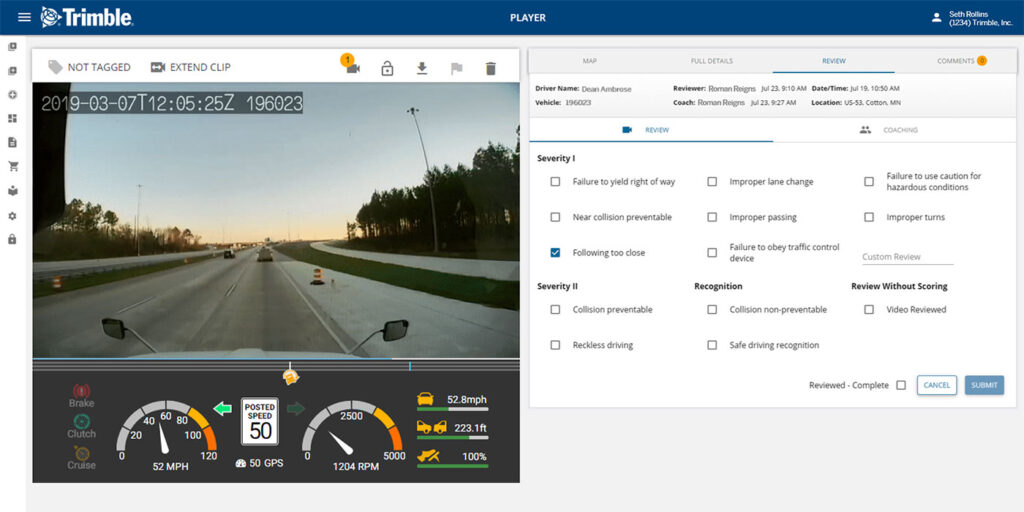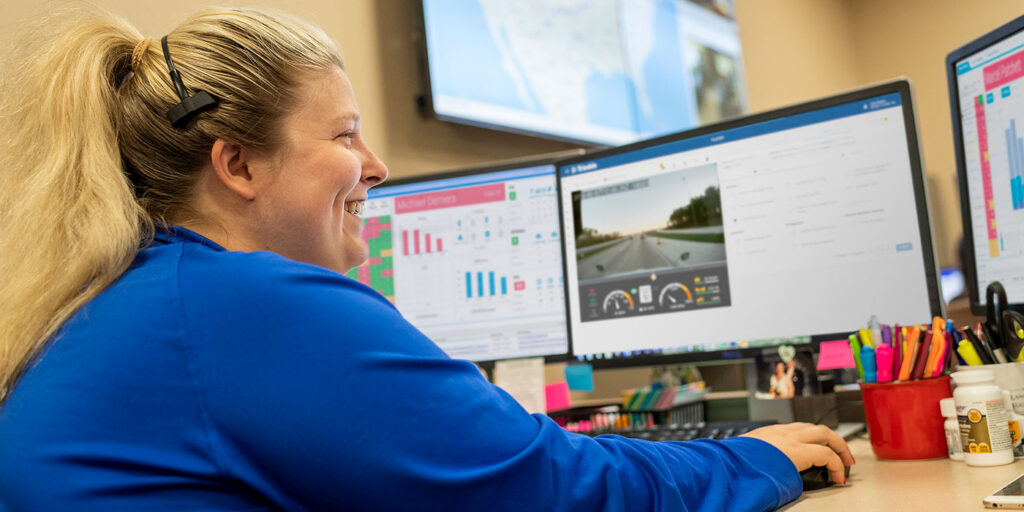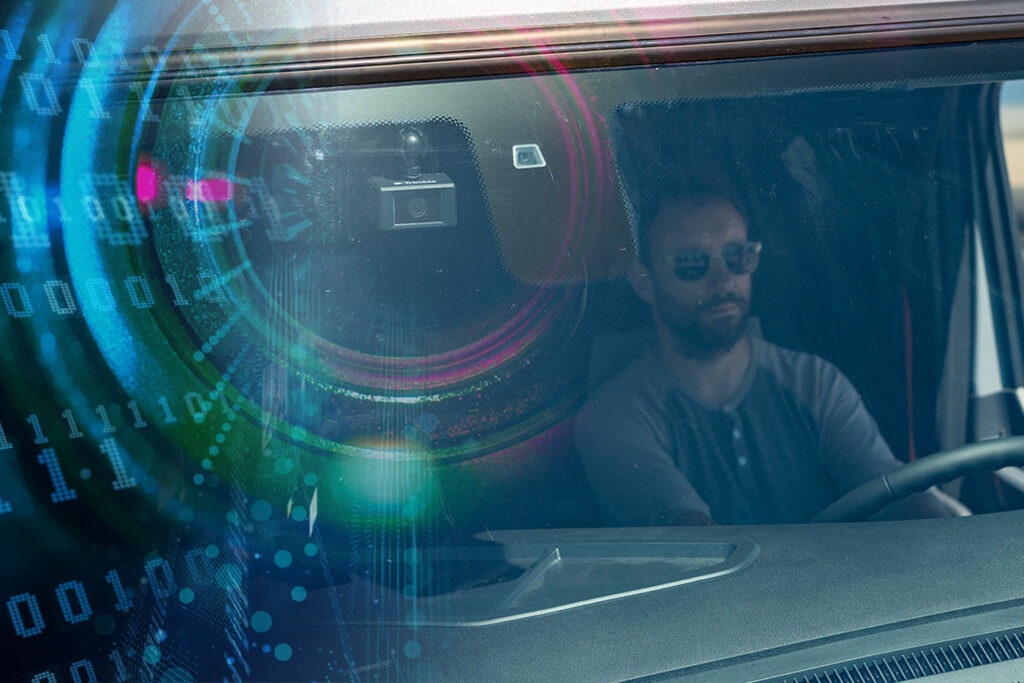Adoption of both outward- and inward-facing cameras for video telematics continues to roll large. As more cameras make their way into more trucks, more questions and use cases arise as fleet managers are given unprecedented visibility into the operation of their trucks. To find out how fleets are leveraging the latest in video telematics and get a bead on what’s coming down the line as the technology continues to evolve, I caught up with Chris Orban, Trimble’s vice president of data science.
Fleet Equipment (FE): When we last talked during Trimble’s in.sight conference, video telematics was front and center. How has video telematics adoption progressed in the past six months?
Orban: We continue to add both technology and customers to our Video Intelligence (VI) platform. Video is a key element for many of our customers, especially as the pandemic has made in-person discussion with drivers more challenging in some ways. The ability to review video of driver behavior and use a platform like VI that can be accessed from anywhere, including the ability to send a video directly to a driver’s personal device, is a very powerful tool in our arsenal.
FE: What conversations are you having with fleets in terms of video telematics that are surprising or unique in their application of the technology?
Orban: One thing that is encouraging to me is that we are seeing much more interest in driver-facing cameras. When I started in transportation 16 years ago, it really wasn’t even considered an option for most fleets — drivers hated the idea, fleets were wary of the technology and what they might find, and of course, concerned about alienating their drivers. Now, with the increase in litigation against trucking companies, as well as the improvements in privacy and blurring technology, we can create tools that allow the driver to be protected, and the company to be informed, without the driver feeling like “Big Brother” is watching.

FE: We also geeked out about action detection last time we talked, how has that that aspect of video technology evolved?
Orban: Action detection is probably the most exciting area of video for me right now. We’re leveraging action detection to build new systems to coach and train drivers in the field based on their own detected actions. The ability to, with minimal (or eventually even no) human intervention, coach every single driver in your fleet every single day would be an amazing leap forward from a safety standpoint. Having the ability to design new types of interventions for drivers, the types of behavior to identify and reward (because good behavior is rarely recognized, since so much emphasis is placed on correcting negative behaviors), and the understanding that every possible avenue has been explored to keep our drivers safe is one of the main reasons I’m in this industry.
FE: Much of this was tied into driver training—what’s the advantage of having the video footage to add to a driver training program?
Orban: I envision a scenario where a new driver can be shown real-world examples of nearly any situation they could find themselves in, so that they see and understand what the real world looks like before they are presented with a snowy mountain road at night. Or they can see what oncoming traffic looks like during a blinding rainstorm. They can understand the long line at the security shack and that they need to be patient — all of these things have happened before and will happen again. This is the sort of training that hours, days, months, years of video footage allow us to create, and this is only the pre-driving training.
The most effective training tool I’ve seen is reviewing a driver’s own video with them and being sure to show them both the positive and negative behaviors. This really brings home the need for action, because it is your behavior, not an abstract training program.

FE: Looking at fleet data usage as whole—what are customers asking you for today? Has a majority of the market moved beyond the entry level, focusing on time in cruise and idle time for ROI, to more advanced data use cases?
Orban: The market is moving very rapidly along the analytics spectrum. To run your transportation business, you have to understand what happened in the past — linear reporting as I think of it. We are getting more and more requests to help companies understand what will happen in the future.
To use your example: Based on my idle trends, freight mix, driver behaviors, and equipment, is a particular lane going to be profitable? Should I invest in a new terminal location? Is a particular customer, which was very profitable last year, going to remain profitable if certain parameters change?
These are all well understood problems in the data science arena, and we certainly have enough data in our industry to address them. Products like Trimble’s Market Insights and Engage.Bid solutions, which are already released, help with some of these, and many more will be following this year.
FE: What technology are you excited about right now and what’s next for Trimble?
Orban: I am most excited about Algorithms as a Service! The concept that we, as Trimble, can provide an answer to a question that a customer (shipper or carrier), or partner, or any third party asks, as long as they are willing to participate in our Transportation Cloud and Trust Center. You don’t necessarily need to have Trimble Video, Telematics or Transportation Management Systems, you just need to have a question that Trimble’s Algorithms can answer.
That question might be “How should I coach this driver?” Or “Is this order appropriate for my network?” It might be “Which driver is best for this order?” And you can control what the Trimble Cloud sees, so if you only want to expose a part of your information, that’s fine. You might not get as many results, or the optimal result you would have gotten if you’d sent more data, but that’s up to you, the customer, to decide how comfortable you are sharing your information.
I believe that the connected supply chain, powering a free and fair marketplace for both carriers and shippers, powered by these Algorithms as a Service, is the most exciting thing Trimble Transportation has in development.
More from Trimble
Visibility and connection are always at the forefront of Trimble conversations. Take a look back at last year’s executive interview where James Langley, Trimble Transportation senior vice president, and Dan Clark, Trimble vice president of product innovation and strategy, talk about sharing data with shippers and providing increased visibility to your business partners.
Chris Orban was also interviewed on our Fleet Future podcast earlier this year—you can catch that conversation here.













